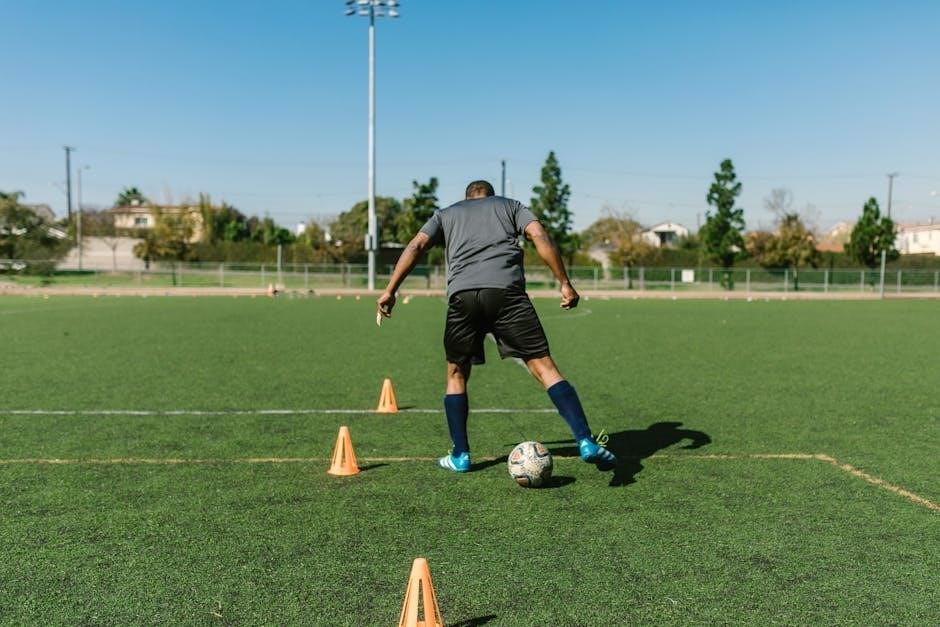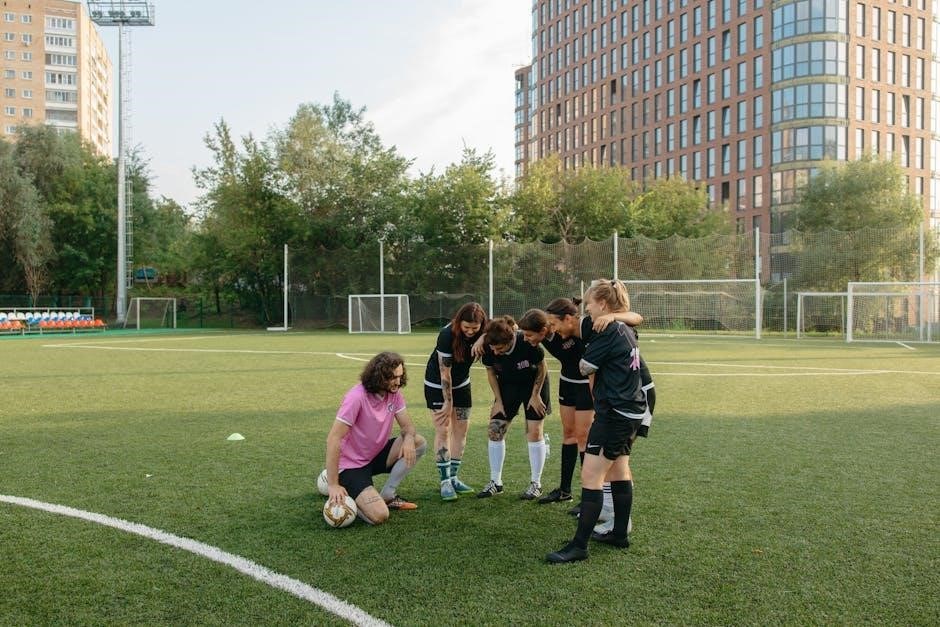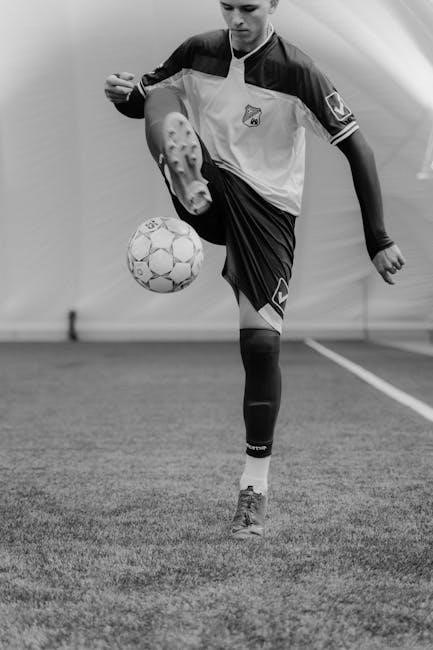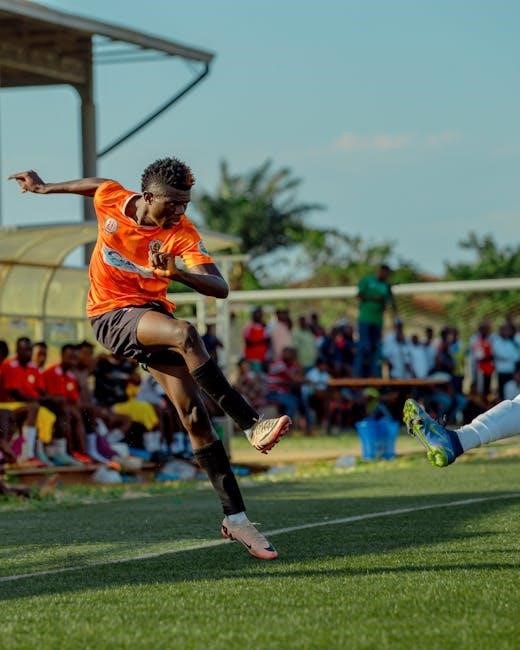U9 Soccer Practice Plans PDF: A Comprehensive Guide
This comprehensive guide offers U9 soccer coaches detailed practice plans in PDF format. These plans focus on fundamental skill development, tactical awareness, and creating a fun, engaging learning environment. Access to structured plans ensures efficient and effective training sessions for young players.
U9 soccer training marks a crucial stage in player development, bridging the gap between introductory play and more structured gameplay. At this age, players are ready to grasp more complex concepts while still maintaining a focus on fun and engagement. Effective U9 training should emphasize building a solid foundation of technical skills, fostering tactical awareness, and promoting teamwork.
Practice sessions should be designed to be dynamic and varied, incorporating drills that develop dribbling, passing, shooting, and ball control. Small-sided games are invaluable for applying these skills in a game-like setting, encouraging decision-making and problem-solving.
Coaches play a vital role in creating a positive and supportive environment where players feel comfortable taking risks and learning from mistakes. Clear communication, constructive feedback, and age-appropriate instructions are essential for maximizing player development. Remember, the goal is not just to improve soccer skills but also to instill a love for the game and build confidence in young athletes. U9 soccer is about laying the groundwork for future success while ensuring players enjoy the journey.
Key Focus Areas for U9 Soccer Development

U9 soccer development necessitates a holistic approach, focusing on several key areas to nurture well-rounded players. Technical skill development is paramount, emphasizing dribbling proficiency, accurate passing and receiving, and effective shooting techniques. Players should be encouraged to practice these skills with both feet, fostering ambidexterity.
Tactical awareness begins to take shape at this age, introducing basic concepts like positioning, spacing, and understanding roles within the team. Small-sided games are crucial for developing tactical understanding in a practical context.
Physical conditioning should be incorporated through age-appropriate activities that improve agility, coordination, and balance. Avoid intense fitness drills, focusing instead on fun, active games that build physical literacy.
Psychological development is equally important, fostering confidence, resilience, and a positive attitude. Coaches should create a supportive environment where players feel comfortable making mistakes and learning from them. Emphasize teamwork, sportsmanship, and respect for opponents and officials.
Finally, game understanding should be cultivated through discussions and observations of matches. Help players recognize patterns of play and make informed decisions on the field. By addressing these key focus areas, U9 soccer development can lay a strong foundation for future success.
Structuring a U9 Soccer Practice Session
A well-structured U9 soccer practice session maximizes player engagement and development within a limited timeframe. Typically, a 60-75 minute session is ideal, broken down into distinct segments.
Begin with a dynamic warm-up (10-15 minutes) incorporating light cardio, stretching, and ball manipulation exercises to prepare muscles and enhance coordination. Progress to technical skill development (20-25 minutes), focusing on one or two core skills like dribbling, passing, or receiving. Use drills that are fun, challenging, and age-appropriate.
Next, dedicate time to small-sided games (20-25 minutes). These games promote tactical understanding, decision-making, and teamwork in a game-like scenario. Vary the game formats (e.g., 3v3, 4v4) to expose players to different challenges and roles.
Conclude with a cool-down (5-10 minutes) involving static stretching and a brief review of the session’s key learning points. Encourage players to reflect on their performance and identify areas for improvement.
Throughout the session, maintain a positive and encouraging atmosphere. Provide clear instructions, demonstrate techniques effectively, and offer constructive feedback. Keep players active and engaged by minimizing downtime and maximizing touches on the ball. Adapt the session based on player needs and skill levels, ensuring everyone is challenged and successful.
Warm-up Activities for U9 Soccer
Effective warm-up activities are crucial for preparing U9 soccer players for practice, reducing the risk of injury and enhancing performance. A well-designed warm-up should gradually increase heart rate, improve blood flow to muscles, and enhance flexibility and coordination.
Start with light cardio exercises like jogging, skipping, or high knees for 5-7 minutes. Incorporate dynamic stretching, such as arm circles, leg swings, and torso twists, to improve range of motion and flexibility. Focus on movements that mimic soccer-specific actions.
Introduce ball manipulation exercises to enhance ball control and coordination. Players can dribble around a designated area, perform toe taps, or practice roll-overs. These activities should be fun and engaging, encouraging players to get comfortable with the ball.
Consider incorporating tag games or modified versions of classic games to add an element of fun and excitement to the warm-up. These games promote agility, quick thinking, and teamwork.
Ensure players are properly hydrated and appropriately dressed for the weather conditions. Monitor their effort levels and adjust the intensity of the warm-up accordingly. Provide clear instructions and demonstrate exercises effectively.
A well-executed warm-up prepares U9 soccer players physically and mentally for the demands of practice, setting the stage for a productive and enjoyable session. It also instills good habits for injury prevention and athletic development.
Technical Skill Drills for U9 Players
Technical skill drills are essential for developing a strong foundation in U9 soccer players. These drills should focus on fundamental skills like dribbling, passing, receiving, and shooting, emphasizing proper technique and repetition.
Dribbling drills should include cone courses, figure-eights, and dribbling with different parts of the foot. Encourage players to keep their heads up and maintain close control of the ball. Focus on agility and changing direction quickly.
Passing and receiving drills should emphasize accuracy, timing, and communication. Players can practice passing in pairs, using both feet, and focusing on proper foot placement and follow-through. Receiving drills should focus on cushioning the ball and controlling it with different parts of the body.
Shooting drills should focus on technique, accuracy, and power. Players can practice shooting from different angles and distances, focusing on proper foot placement and striking the ball cleanly.
Introduce small-sided games that incorporate these technical skills. This allows players to apply what they’ve learned in a game-like situation. Encourage creativity and decision-making.
Keep the drills fun and engaging by using games and challenges. Provide positive reinforcement and constructive feedback to help players improve. Adjust the difficulty of the drills based on the players’ skill levels.
Remember to focus on individual development and create a positive learning environment. Technical skill drills are the building blocks for future success in soccer.
Passing and Receiving Drills
Passing and receiving drills are critical for U9 soccer players, fostering teamwork and ball control. These drills should emphasize proper technique, accuracy, and quick decision-making. Start with simple partner passing, focusing on using the inside of the foot for accuracy and control. Gradually introduce variations, such as passing with the outside of the foot or using different surfaces for receiving.
A great drill is the “triangle passing” drill, where three players form a triangle and practice passing and receiving in sequence. This improves spatial awareness and communication. Another effective drill is the “wall pass,” where players pass the ball against a wall and receive the rebound, focusing on quick touches and accurate passes.
Incorporate movement into the drills, such as having players move after passing or receiving to create new passing lanes. This simulates game-like situations and encourages dynamic play. Emphasize the importance of communication, both verbal and non-verbal, to coordinate passes and movements.
Introduce challenges, like hitting a target with a pass or completing a certain number of passes in a row without mistakes. This adds an element of fun and competition, keeping players engaged. Provide constructive feedback on technique and decision-making, helping players improve their skills.
Remember to keep the drills age-appropriate and adjust the difficulty based on the players’ skill levels. Focus on creating a positive and supportive learning environment, where players feel comfortable making mistakes and learning from them.
Dribbling and Ball Control Exercises
Dribbling and ball control are foundational skills for U9 soccer players. Exercises should focus on developing close control, agility, and confidence on the ball. Begin with simple cone drills, where players dribble the ball through a series of cones, using different parts of their feet. Encourage players to keep their heads up to improve awareness of their surroundings.
Introduce variations, such as dribbling with only the left foot, only the right foot, or alternating feet. Add challenges, like dribbling at different speeds or performing specific turns around the cones. Another effective exercise is the “dribbling square,” where players dribble within a designated square, focusing on maintaining control and avoiding collisions with other players.
Incorporate games, such as “red light, green light,” where players dribble until the coach calls “red light,” at which point they must stop the ball immediately. This improves reaction time and ball control under pressure. Emphasize the importance of using small, quick touches to maintain control and protect the ball from defenders.
Introduce feints and turns, such as the step-over or the Cruyff turn, to help players beat defenders. Encourage creativity and experimentation, allowing players to develop their own unique dribbling styles. Provide constructive feedback on technique and decision-making, helping players refine their skills.
Remember to keep the exercises age-appropriate and adjust the difficulty based on the players’ skill levels. Focus on creating a fun and engaging learning environment, where players feel comfortable making mistakes and learning from them. Celebrate successes and encourage players to challenge themselves.
Shooting Practice for U9 Soccer
Shooting practice for U9 soccer players should prioritize developing proper technique and building confidence in front of the goal. Start with stationary shooting drills, focusing on striking the ball with the inside of the foot for accuracy and the laces for power. Emphasize the importance of planting the non-kicking foot next to the ball and following through towards the target.
Progress to shooting on the move, incorporating dribbling and passing into the drills. Set up cones to create a slalom course, where players dribble through the cones before taking a shot on goal. This helps develop dribbling skills and shooting under pressure. Another effective drill is the “pass and shoot,” where players pass the ball to a teammate, who then lays it off for a shot.
Introduce different types of shots, such as bending shots and volleys, as players become more proficient. Encourage players to experiment with different techniques and find what works best for them. Incorporate small-sided games with a focus on shooting opportunities. This allows players to practice their shooting skills in a more game-like environment.
Provide constructive feedback on technique and decision-making, helping players refine their shooting skills. Emphasize the importance of accuracy over power, especially at this age. Celebrate successes and encourage players to take risks and try new things. Remember to keep the drills fun and engaging, focusing on creating a positive learning environment.
Small-Sided Games for U9 Soccer (7v7)


Small-sided games are crucial for U9 soccer development, particularly the 7v7 format, as they maximize player involvement and decision-making opportunities. These games provide a platform to apply skills learned in drills within a more realistic game context. Emphasize the importance of teamwork, communication, and spatial awareness during these games.
When designing 7v7 games, consider the field size and player positioning to encourage passing and movement. Limit instructions during play to allow players to problem-solve and develop their own tactical understanding. Encourage players to experiment with different positions and roles to foster versatility.
Focus on creating game scenarios that promote specific skills, such as attacking combinations, defensive positioning, or transitioning from defense to attack. Incorporate variations in the rules or field setup to challenge players and encourage adaptability. For example, introduce a rule that requires a certain number of passes before a team can shoot, or create zones that players must pass through.
Ensure equal playing time for all players, regardless of skill level. Use positive reinforcement and constructive feedback to help players learn from their mistakes. Emphasize the importance of effort and sportsmanship over winning. These games should be fun and engaging, fostering a love for the game and a desire to improve. Regularly rotate players to different positions.
Tactical Awareness and Game Understanding

Developing tactical awareness and game understanding in U9 soccer players is essential for their long-term development. At this age, focus on introducing basic tactical concepts in a simple and engaging manner. Avoid overwhelming players with complex strategies; instead, prioritize fundamental principles like spacing, support, and movement off the ball.
Teach players to recognize different areas of the field and their corresponding roles. Explain the importance of maintaining a balanced formation and adjusting positions based on the ball’s location. Encourage players to communicate with each other and work together as a team.
Use small-sided games and training exercises to simulate game scenarios and promote tactical decision-making. Create situations that require players to make choices about passing, dribbling, and shooting. Provide opportunities for players to experiment with different strategies and learn from their mistakes.
Emphasize the importance of anticipating the opponent’s movements and making quick decisions under pressure. Teach players to recognize when to pass, when to dribble, and when to shoot. Encourage them to think about their options and make informed choices based on the game situation.
Regularly review game footage with players to analyze their tactical decisions and identify areas for improvement. Provide constructive feedback and encourage players to ask questions. Focus on fostering a growth mindset and creating a learning environment where players feel comfortable taking risks. Promote improvisation.
Cool-down and Review
The cool-down and review segment is a crucial, often overlooked, component of a well-structured U9 soccer practice. This phase serves a dual purpose: physically winding down the players and reinforcing the key learning objectives of the session. A proper cool-down helps prevent injuries and reduces muscle soreness, ensuring players are ready for the next training.
Begin with light aerobic activity, such as jogging or brisk walking, for about five to seven minutes. Follow this with static stretching, holding each stretch for 20-30 seconds. Focus on major muscle groups used during the practice, including hamstrings, quadriceps, calves, and hip flexors. Encourage players to communicate any discomfort or tightness they may be experiencing.
The review component provides an opportunity to recap the skills and concepts covered during the session. Ask players questions about the drills, challenges they faced, and what they learned. This reinforces their understanding and helps identify areas where further instruction may be needed.
Keep the review concise and engaging, using positive language and encouragement. Highlight individual and team successes, fostering a sense of accomplishment and camaraderie. This practice links effort to performance. Briefly preview the next practice session, piquing their interest and setting expectations. End on a positive note, reinforcing the fun and enjoyment of the game. This contributes to their overall development and love for soccer.
Resources for U9 Soccer Coaches
Finding U9 Soccer Practice Plans in PDF Format
Locating suitable U9 soccer practice plans in PDF format can be a game-changer for coaches seeking structured training resources. Several avenues exist for accessing these valuable materials, both online and through local soccer organizations.
Start by exploring reputable soccer coaching websites and online forums dedicated to youth soccer development. Many of these platforms offer free or premium downloadable practice plans tailored specifically for the U9 age group. Keywords such as “U9 soccer drills PDF,” “youth soccer practice plans,” and “7v7 soccer training” will yield relevant results.
Check the websites of national and regional soccer associations, as they often provide coaching resources, including age-specific practice plans. Local soccer clubs and leagues may also offer practice plans to their coaches, sometimes in PDF format.
Consider utilizing online search engines like Google, Bing, or DuckDuckGo, employing specific search terms to narrow down your results. Refine your search by adding terms related to specific skills or tactical concepts, such as “U9 passing drills PDF” or “U9 defensive tactics training.”
Remember to evaluate the credibility and quality of the source before implementing any practice plan. Look for plans that align with established youth soccer development principles and are age-appropriate for your players. Preview available plans and always prioritize safety and fun.
